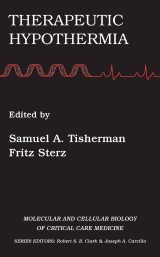Details

Therapeutic Hypothermia
Molecular & Cellular Biology of Critical Care Medicine, Band 4
|
213,99 € |
|
| Verlag: | Springer |
| Format: | |
| Veröffentl.: | 03.04.2007 |
| ISBN/EAN: | 9780387254036 |
| Sprache: | englisch |
| Anzahl Seiten: | 258 |
Dieses eBook enthält ein Wasserzeichen.
Beschreibungen
Samuel A. Tisherman, MD', Fritz Sterz, MD~ '~niversit~ of Pittsburgh, Pittsburgh, PA, USA 2~edical University of Vienna, Vienna, Austria The use of hypothermia for a variety of therapeutic purposes has a long and erratic history. Hippocrates recommended the use of topical cooling to stop bleeding. Fay used cooling of the extremities for patients with tumors in the 1930s. It wasn't until the 1950s, when the effects of hypothermia on systemic oxygen metabolism became better defined, that systemic hypothermia became a commonly used modality, particularly for cardiac surgery. Hypothermia was used for protection (treatment before the insult) and preservation (treatment during the insult) of the heart and entire organism during planned operative ischemia. Shortly thereafter, attempts were made to use hypothermia for resuscitation (treatment after the insult) from cardiac arrest and for management of head trauma. At that time, it was felt that moderate hypothermia (28-32OC) was needed. This was difficult to achieve and manage. Multiple complications were noted. Consequently, therapeutic, resuscitative hypothermia lay dormant for many years while mild (32-35°C) to moderate hypothermia became common for many cardiothoracic and neurosurgical procedures. In the early 1990s, it was found that mild hypothermia, even after cardiac arrest, had benefit for the brain. Similar results were found with head trauma. This lead to a burst of enthusiasm for research into resuscitative hypothermia for a variety of insults, most of which have tissue ischemia as a major component.
Global Brain Ischemia: Animal Studies.- Global Cerebral Ischemia: Clinical Studies.- Focal Cerebral Ischemia: Mechanisms.- Focal Cerebral Ischemia: Clinical Studies.- Traumatic Brain Injury: Laboratory Studies.- Traumatic Brain Injury: Clinical Studies.- Spinal Cord Ischemia and Trauma.- Asphyxia.- Neonatal Asphyxia.- Hemorrhagic Shock and Exsanguination Cardiac Arrest.- Adult Respiratory Distress Syndrome and Sepsis.- Liver Failure and Intracerebral Hypertension.- Myocardial Ischemia and Infarction.- Cooling Methods.- Detrimental Effects of Hypothermia.- Future Directions.
<P>The use of hypothermia for a variety of therapeutic purposes has a long and erratic history. Hypothermia was used for protection and preservation of the heart and entire organism during planned operative ischemia. Attempts were also made to use hypothermia for resuscitation from cardiac arrest and for management of head trauma.</P>
<P><EM>Therapeutic Hypothermia</EM> will provide a review of the subject, in particular, resuscitative hypothermia and include known mechanisms of action and results from both mechanistic and outcome laboratory studies and clinical trials. Cooling methods and potential side effects of hypothermia will be addressed as well as recommendations for future laboratory and clinical research.</P>
<P>This volume will be of interest to both the researcher interested in therapeutic hypothermia as well as the clinician interested in the potential use of therapeutic hypothermia in their patient population.</P>
<P>Samuel A. Tisherman is an Associate Professor in the Department of Surgery, the University of Pittsburgh, Pennsylvania, USA.</P>
<P>Fritz Sterz is a Professor in Emergency Medicine at the University of Vienna, Vienna, Austria.</P>
<P><EM>Therapeutic Hypothermia</EM> will provide a review of the subject, in particular, resuscitative hypothermia and include known mechanisms of action and results from both mechanistic and outcome laboratory studies and clinical trials. Cooling methods and potential side effects of hypothermia will be addressed as well as recommendations for future laboratory and clinical research.</P>
<P>This volume will be of interest to both the researcher interested in therapeutic hypothermia as well as the clinician interested in the potential use of therapeutic hypothermia in their patient population.</P>
<P>Samuel A. Tisherman is an Associate Professor in the Department of Surgery, the University of Pittsburgh, Pennsylvania, USA.</P>
<P>Fritz Sterz is a Professor in Emergency Medicine at the University of Vienna, Vienna, Austria.</P>
Fourth book in the Molecular and Cellular Biology of Critical Care Medicine series Emphasizes resuscitative hypothermia Global perspective on topic
Diese Produkte könnten Sie auch interessieren:

Aktinische Keratosen - medizinisches Grundwissen und NEUE Therapieansätze (Carcinomata in situ)

von: Hellene von Waldgraben

9,99 €

Manual clínico de los antidepresivos

von: Victor R. Uriarte Bonilla, Victor R. Uriarte Editorial Alfil, S. A. de C. V.

23,99 €














